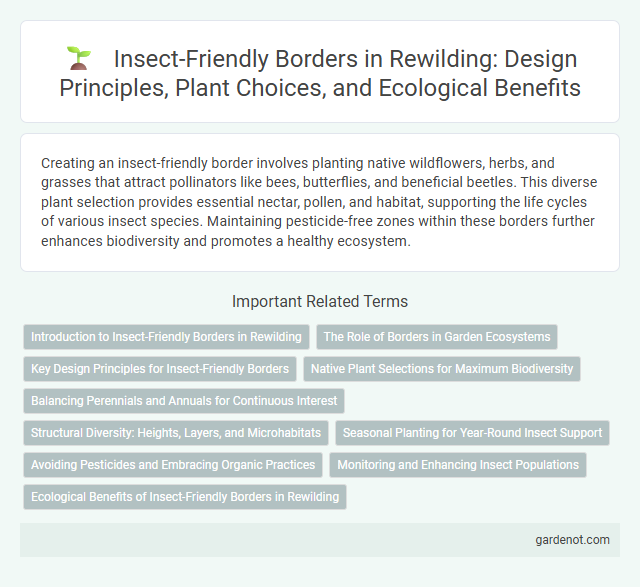Creating an insect-friendly border involves planting native wildflowers, herbs, and grasses that attract pollinators like bees, butterflies, and beneficial beetles. This diverse plant selection provides essential nectar, pollen, and habitat, supporting the life cycles of various insect species. Maintaining pesticide-free zones within these borders further enhances biodiversity and promotes a healthy ecosystem.
Introduction to Insect-Friendly Borders in Rewilding
Insect-friendly borders play a crucial role in rewilding by creating habitats that support pollinators and beneficial insects essential for ecosystem health. These borders typically consist of native flowering plants, grasses, and shrubs that provide food, shelter, and breeding grounds for a variety of insect species. By enhancing biodiversity and promoting natural pest control, insect-friendly borders contribute significantly to the restoration and sustainability of natural landscapes.
The Role of Borders in Garden Ecosystems
Insect-friendly borders create essential habitats that support pollinators, predators, and decomposers, enhancing biodiversity within garden ecosystems. These borders provide nectar-rich flowers and shelter, promoting natural pest control and improving plant health. Incorporating native plants in borders fosters ecological balance, making rewilding efforts more effective and sustainable.
Key Design Principles for Insect-Friendly Borders
Insect-friendly borders prioritize diverse native flowering plants to provide continuous nectar sources and habitat throughout the growing season. Incorporating layered vegetation structures enhances shelter and breeding sites for pollinators and beneficial insects. Soil health management, including minimizing chemical use and maintaining organic mulch, supports robust insect populations and ecosystem stability.
Native Plant Selections for Maximum Biodiversity
Selecting native plants for insect-friendly borders significantly enhances local biodiversity by providing essential habitats and food sources for pollinators such as bees, butterflies, and beetles. Native species like Echinacea, Asclepias, and Solidago support specialized insect populations adapted to local conditions, promoting ecological balance and resilience. Incorporating a diverse range of flowering periods and plant structures maximizes nectar and pollen availability, sustaining insects throughout their life cycles and encouraging robust ecosystem health.
Balancing Perennials and Annuals for Continuous Interest
Creating an insect-friendly border involves balancing perennials and annuals to ensure continuous bloom and habitat throughout the growing season. Perennials provide stability and recurring food sources for pollinators, while annuals fill gaps with vibrant, seasonal nectar and pollen. This strategic combination enhances biodiversity, supports pollinator populations, and sustains ecosystem health year-round.
Structural Diversity: Heights, Layers, and Microhabitats
Insect-friendly borders designed with structural diversity incorporate varying plant heights, multiple vegetation layers, and diverse microhabitats to support a wide range of insect species. Tall grasses, flowering perennials, and low-growing ground covers create vertical stratification that offers shelter, foraging opportunities, and breeding sites for pollinators, predators, and decomposers. Microhabitats such as leaf litter, bare soil patches, and woody debris further enhance biodiversity by providing niche environments critical for insect life cycles in rewilding projects.
Seasonal Planting for Year-Round Insect Support
Insect-friendly borders with carefully selected seasonal planting provide continuous nectar and pollen sources vital for pollinators throughout the year. Incorporating native wildflowers, grasses, and flowering shrubs ensures diverse habitats that support bees, butterflies, and beneficial insects during all seasons. This approach strengthens local ecosystems by enhancing biodiversity and promoting sustainable insect populations essential for pollination and natural pest control.
Avoiding Pesticides and Embracing Organic Practices
Insect-friendly borders thrive by avoiding pesticides and embracing organic practices, fostering biodiversity and supporting pollinator populations. Organic soil management and natural pest control methods create a safe habitat for beneficial insects, enhancing ecosystem resilience. Prioritizing chemical-free gardening promotes sustainable growth and ensures the health of vital insect species essential for rewilding efforts.
Monitoring and Enhancing Insect Populations
Insect-friendly borders play a crucial role in rewilding by providing diverse habitats that support pollinators and beneficial insects. Regular monitoring using bioacoustic tools and population surveys helps track species diversity and abundance to assess ecosystem health. Enhancing insect populations involves planting native wildflowers and reducing pesticide use to foster a resilient and balanced insect community.
Ecological Benefits of Insect-Friendly Borders in Rewilding
Insect-friendly borders enhance biodiversity by providing essential habitats and food sources for pollinators, predatory insects, and decomposers, thereby supporting ecosystem resilience and stability. These habitats contribute to natural pest control, reducing the need for chemical pesticides and fostering healthier plant communities in rewilded areas. By promoting insect diversity, these borders facilitate nutrient cycling and plant pollination, crucial processes sustaining ecological balance and the overall success of rewilding initiatives.
Insect-friendly border Infographic

 gardenot.com
gardenot.com